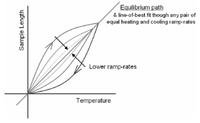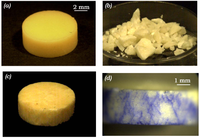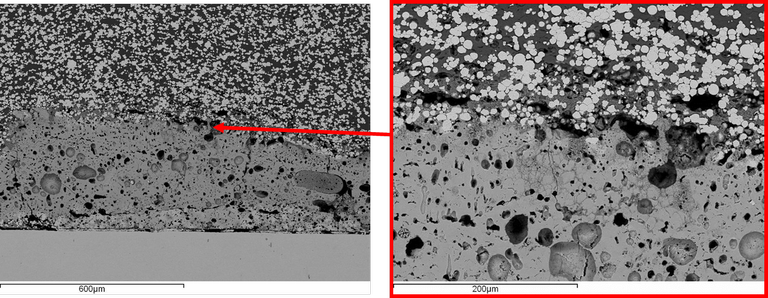We aim to understand a wide range of fast dynamical processes in materials at the most fundamental level accessable. We specialise in producing high quality experimental data and develop cutting-edge and innovative techniques for understanding ultra-fast phenomena, including developing optical diagnostics and using high speed photography.
We work closely with a number of industrial partners, and actively participate in a wide variety of research projects. We are always happy to discuss possible projects and our wide range of experience allows us to offer practical advice on ways to obtain data on fast processes. We can perform a wide range of research in-house, but can usually put you in touch with other experts if we cannot.
Fracture and shock physics research has been on-going in the group since the late 1940's. It is inevitable that over such a long period of time the interests of the group will change depending on the scientific interests of its members and the community as a whole, and while this page highlights research topics which are under active investigation (or have been in the last few years), a number of research topics that are not currently under active investigation are not discussed - but further information can be found here. The above is not to say however that these topics might not return to the fore in future years, and indeed the group often undertakes smaller projects around similar themes and retains and maintains the equipment and facilities to conduct such investigations.
Energetic Materials
Energetic materials cover a wide range of substances capable of releasing large amount of chemical energy quickly, and include propellants, pyrotechnics and explosives. Understanding the properties and mechanisms that control the behaviour of these materials is a substantial physical challenge, and requires a detailed understanding of the physical properties of the material. These properties can then be linked together using various theoretical techniques, including for example, the polymer Group Interaction Model (GIM) framework.
The group has a long history in studying the characteristics of energetic materials, dating back to the late 1940’s. Today we focus on applying modern methods to develop a much more complete understanding of the fundamental behaviour. A particular focus is on developing and instrumenting small scale experiments which can be used to provide fundamental insights enabling accurate models to be constructed, to understand larger scale response.We use a variety of techniques to characterise the underlying physical properties of materials. These include thermal expansion (using direct and optical interferometric methods), heat capacity (using differential scanning calorimetry), thermal conductivity and differential mechanical analysis. Together, these can be combined to study the underlying thermodynamics and statistical mechanics of the materials.
We characterise the structures of complex energetic materials using various forms of microscopy and non-invasive 3-dimensional imaging techniques, such as X-ray Computed Tomography. We have several ongoing projects to characterise the adhesive interaction between different materials, and the corresponding effect this has on the ultimate strength on the material.
Damage in energetic materials is a particularly important area. Damage can lead to an increased likelihood of energetic initiation, so understanding damage in detail is an important element of the explosive safety. We have several ongoing projects which include introducing controlled amounts of damage into energetic materials (propellants, PBXs) and studying the changes in both physical and energetic properties, as described in the papers below.
Novel fabrication methods for energetic materials are of particular interest. For example, we have recently been involved in a project to develop screen printable pyrotechnic inks, to reduce lead usage within the mining industry.
Fibre Composites
Similarly to granular and geological materials, the properties of composites (e.g. GFRP and CFRP) depend on both the material properties of constituent elements, and their micro-, meso- and macro-scale structure. Probing the rate-dependent behaviour of such materials poses a particular challenge - watch this space!
Recent research has been directed towards investigating the mechanical properties of sea shells. These are nanocomposites comprising of ~99% calcium carbonate within an organic matrix. Shells have been shown to have excellent strength and fracture toughness properties compared to their components. The behaviour of these materials in tough erosive environments is of particular interest and we are using MIJA and other erosion equipment to quantify the different failure mechanisms involved. Prototype shell 'mimics' are expensive and small scale, so it is important to have reliable, reproducible testing methods which enable quantitative measurements to be made.
Polymers
Polymers are a diverse family of materials with a wide range of applications in industries such as automotive, medical, defence and others. It is therefore important to understand their properties under a range of conditions.
In our group, we utilise our experimental capabilities to measure polymer properties. We can measure heat capacity in the temperature range 25-450 K and thermal expansion in the range 120-420 K. In terms of mechanical properties, we have measuring capabilities from quasistatic rates in the Instron, moderate rates in the DMA machine and high rates in the Hopkinson bar, impact tests, and ultrasonic and shock measurements.
We use our datasets to populate models for structure-property relations of polymers. In particular, the group has been working with Group Interaction Modelling, which is a framework that uses the chemical structure and configuration of the polymer chain to predict its bulk properties.
Metals
Understanding the mechanical and microstructural properties of metals is of great importance both in terms of the fundamental science involved and also in the application of this science owing to the high level of usage of metallic objects. A variety of models are available to predict the response of metals in various situations, with varying levels of physical basis. An important area which is not well understood is how these different models can be applied to predict material behaviour with increasing strain rate, leading onto failure, particularly as a function of the initial condition of the material. This knowledge of the original state is known as path or history dependence.
Completely characterizing path dependence requires a wide range of experimental techniques. Most notable are those at medium to high rates, such as Split Hopkinson Pressure Bar experiments, where effects caused by sample inertia need to be discerned from the true material response.Numerical simulation is key to applying and testing the models which are used to predict this behaviour. The research carried out in this group aims to aid in the parameterisation of these models, and to develop them to better describe the experimentally observed nature of path dependence.
Granular and geological materials
In recent years the group has conducted a significant amount of research concerning geological and granular materials. This has looked at many different materials including fully dense and porous rock, sands and soils, concrete, ceramics, pressed metal powders, metallic and polymer foams, and porous energetic materials. Much of this research involved measuring the response of these materials to quasi-static, dynamic and shock loading.
Geological and granular materials are important for many applications and most of this work has been done in collaboration with researchers from the mining, defence and aerospace sectors. The group has investigated shock compaction in many porous materials. This research involved plate impact experiments to measure the Hugoniot and release of these porous materials and using shock compaction models to describe the behaviour. The group has also looked at the effect of grain size, morphology and moisture on the shock compaction.
Recent research has investigated the fracture and fragmentation of geological materials under dynamic and shock loading though brazilian disc and explosively driven expanding ring experiments. These experiments included the use of high speed photography to observe crack growth , fragment size analysis and fractography of the samples post-experiment.
The group is also interested in wave propagation in granular materials. The non-linear mechanical nature of grain contacts results in granular materials having significantly lower sound speeds compared to fully dense materials. This phenomenon has been investigated through sound speed measurements and high speed photography on real granular materials, like sand, and idealised systems such as chains of identical spheres.
Research has also looked at ballistic penetration into sand and concrete. In these experiments a flash X-ray system and digital image correlation was used to observe flow within the material during penetration.
Reactive metals
While traditional energetic materials have many and varied uses, there are a number of things that they are rather poor at, for example it is very difficult to make structural components from them. One potential way around some of these limitations is to make components out of reactive metal components. Currently this subject is the focus of a large number of research programmes across the world, and to date the group has been involved in two separate initiatives to examine metallic reactions and the mechanical properties of reactive metal mixtures.
The first project was to examine the performance of systems containing powdered nickel and aluminium. This involved examining the microstructures formed when these materials are pressed together to different densities, looking at their mechanical properties and finally examining the reactivity. This project utilised a very wide range of the experimental apparatus within the group, including the Inston, Hopkinson Bars, gas guns and high speed cameras (see facilities). Modelling work was also carried out by QinetiQ to link in with the experimental effort
.
Two micrographs showing unreacted (top) and reacted (bottom) microstructure in a shock loaded nickel-aluminium powder bed.
The second project was involved collaborations with academic partners from UCSD, Georgia Tech and Johns Hopkins (see below). The main focus of this project was to examine how different manufacturing techniques for reactive metal combination would affect mechanical properties, and specifically fragmentation properties. The research was into a number of metallic combinations with the aim either of forming intermetallics, or enabling the rapid combustion of aluminium though fragmentation to a very small scale. Manufacturing techniques examined included cold and hot isistatic pressing, swaging, gas dynamic cold spray and explosive compaction. Much of the research involved examining materials under explosive loading and obtaining both time resolved photographic and velocimetry data as well as allowing for soft capture of fragments post experiment.
Space penetrators
Since the end of the cold war and with it the associated desire for a space race it has become increasingly important to make sure that space exploration delivers good value for money. In the current economic climate this is particularly important, and has lead to agencies looking for mission types that go beyond the traditional approached of manned missions, satellites and soft landers. Missions such as the ill fated Beagle 2 and the much more successful Deep Impact and LCROSS spacecraft have demonstrated the potential of such efforts.
We have been working with Astrium, MSSL, QinetiQ and ESA over a number of years to develop a penetrator concept for exploring planetary bodies throughout the solar system. The idea is to pack scientific instruments into a hardened steel shell and embed them below the surface of the planet or moon of interest (the currently envisaged target is Europa). This is a very cost effective method of delivering instrumentation (as it doesn't have to be soft landed) and additionally allows for sub-surface science to be conducted (which is generally not possible by other methods).
In the laboratory the aim has been to investigate small scale survivability of the penetrator system. Specifically this has meant impacting a number of things in our gas gun facilities:
- Impacting the components for the mission in a representative way to ensure they are able to withstand the high acceleration loadings expected during planetary impact.
- The penetrator will have a dual skin design (to provide thermal isolation) with the inner shell held away from the outer by Torlon springs. The springs were shot in the gun to investigate their properties under high rate loading.
- In order to obtain samples from the planetary body it is necessary to have a hole in the outer steel shell. Various scaled penetrators were impacted to determine the level of deformation that could be expected.
Subsequent to the laboratory investigations the penetrator system was tested at a large scale at the Pendine Test Range in Wales. This facility (operated by QinetiQ) consists of a rocket sled which accelerates
This project has been mainly led by Dr. Nick Taylor as a postdoctoral research associate, with some input at an early stage from Dr. Chris Braithwaite.
The early concept for the penetrators is detailed in the following paper:
Specific details of the Europa penetrators are here:
Various news articles have been generated, a selection of which are below:
British space penetrator passes icy test
Missile practice for Moon mission




